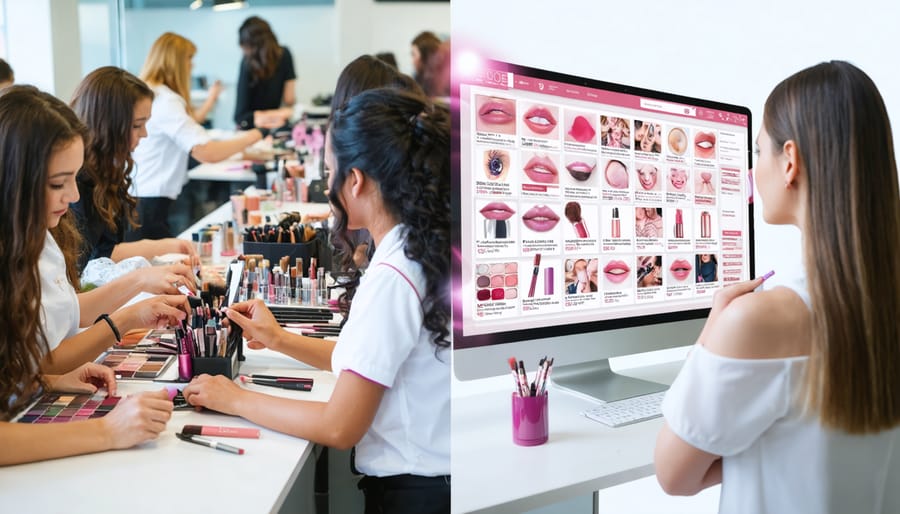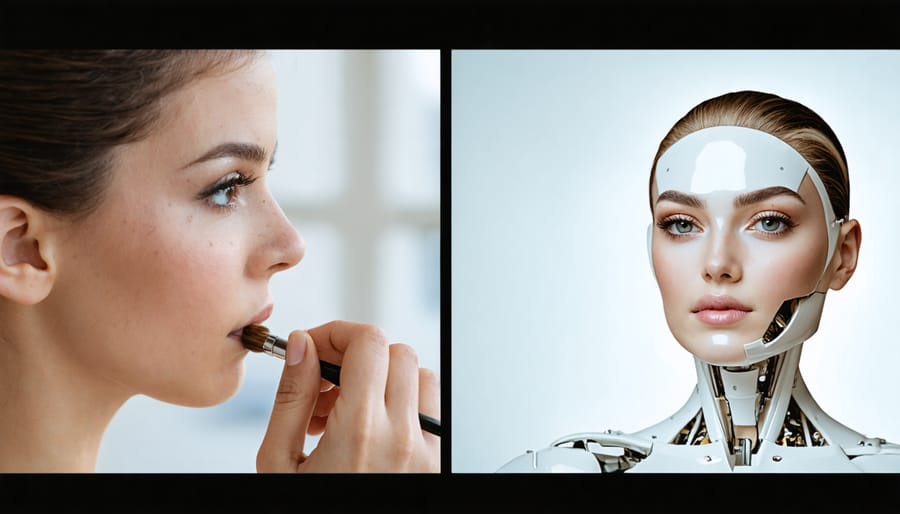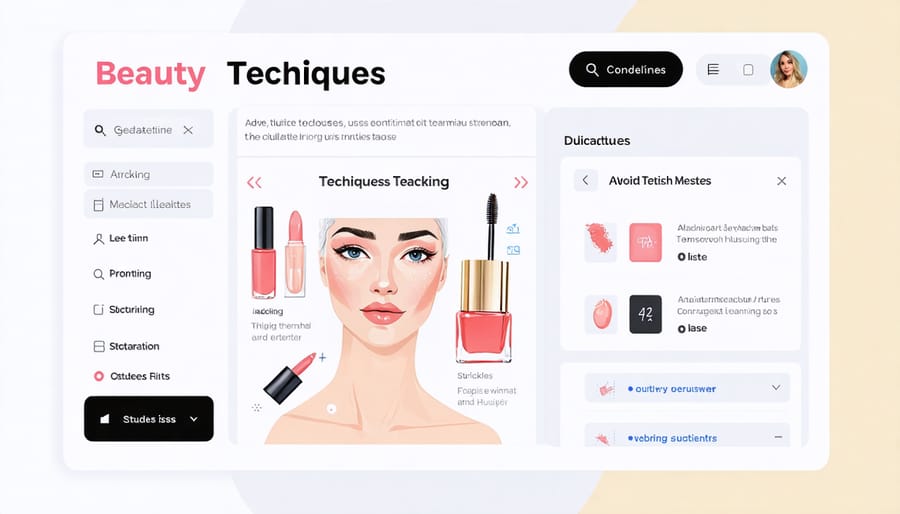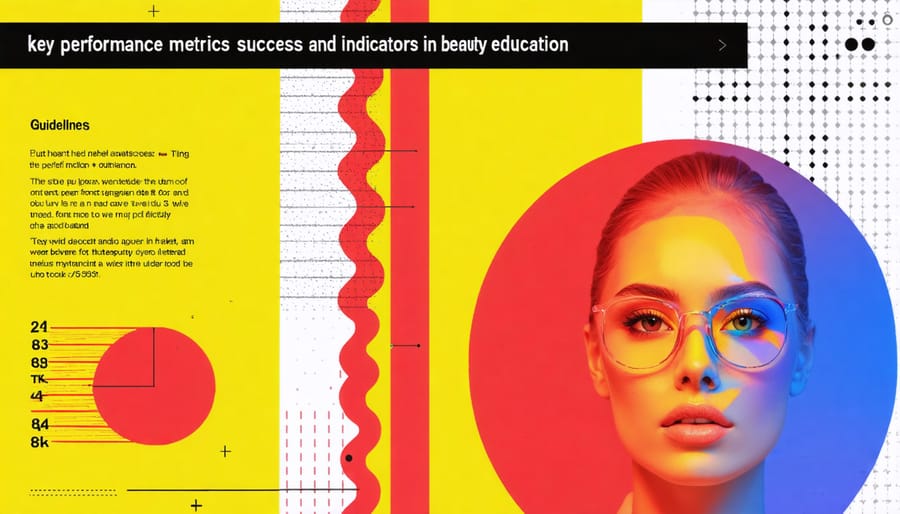
The digital revolution in beauty education isn’t just trending—it’s transforming how we teach, learn, and transform your beauty business. E-learning has emerged as a game-changing solution for beauty professionals seeking to scale their expertise beyond the traditional classroom walls.
With the global e-learning market projected to reach $350 billion by 2025, beauty educators are uniquely positioned to capitalize on this digital gold rush. Whether you’re a seasoned beauty school owner or a solo practitioner looking to share your expertise, creating an online education platform offers unprecedented opportunities to reach students worldwide while maintaining the intimate, hands-on nature of beauty training.
The beauty of e-learning lies in its flexibility and scalability. Imagine teaching advanced coloring techniques to hundreds of students simultaneously, or helping aspiring makeup artists perfect their craft through high-definition video demonstrations and interactive feedback sessions. This digital transformation isn’t just about survival in a changing market—it’s about thriving in an industry that increasingly values accessibility, convenience, and innovation.
Moving your beauty education business online isn’t just a strategic move; it’s an investment in the future of beauty education. By embracing e-learning now, you’re not just adapting to change—you’re leading it, creating a more inclusive and accessible future for beauty education while building a sustainable, scalable business model that can weather any storm.
Why Traditional Beauty Education Isn’t Enough Anymore
The Digital Beauty Revolution
Remember when beauty education meant sitting in a crowded classroom, straining to see the instructor demonstrate techniques? Those days are rapidly becoming a distant memory. Today’s beauty professionals are embracing a digital transformation that’s revolutionizing how we learn and teach beauty skills.
I’ve watched countless students light up when they discover they can replay complex tutorials at their own pace or zoom in on detailed techniques they might have missed in a traditional classroom. Online platforms have made beauty education more accessible and personalized than ever before.
What’s truly exciting is how this shift has empowered both students and educators. Beauty professionals can now learn from international experts without leaving their hometown, while instructors can reach global audiences from their local studios. The integration of virtual try-on tools, 3D modeling, and interactive practice sessions has created an immersive learning experience that was unimaginable just a few years ago.
This digital revolution isn’t just changing how we learn – it’s transforming customer expectations. Clients now seek professionals who stay current with the latest techniques through continuous online education, making e-learning not just a convenience, but a competitive necessity in today’s beauty industry.

Real-World Skills Gap
While e-learning has revolutionized education, there are certain hands-on skills that require in-person practice and real-time feedback. I’ve seen this firsthand in my years of teaching – some techniques simply can’t be mastered through a screen alone. Think about the intricate details of a perfect facial massage or the precise pressure needed for various beauty treatments. These nuances are best learned through physical practice and immediate instructor guidance.
That’s why successful e-learning programs often adopt a hybrid approach. For instance, students might learn theory, watch technique videos, and complete written assignments online, but then attend practical workshops or supervised sessions for hands-on experience. This blended learning style ensures students develop both knowledge and practical competency.
Consider setting up periodic in-person meetups or practical assessment days where students can demonstrate their skills and receive real-time feedback. These sessions not only help validate learning outcomes but also create valuable networking opportunities within your professional community. Remember, while technology can facilitate learning, some aspects of skill development will always benefit from human interaction and physical practice.
Building Your Hybrid Beauty Learning Model
Digital Foundations
Building a successful e-learning platform for your beauty business requires a strong digital foundation that seamlessly blends technology with educational excellence. Today’s beauty professionals expect more than just basic video tutorials – they’re looking for an immersive, interactive experience that mirrors the hands-on nature of our industry.
Start with a user-friendly learning management system (LMS) that can host your courses, track student progress, and facilitate engagement. Popular platforms like Teachable or Thinkific offer beauty-specific features and are perfect for beginners. Consider incorporating a hybrid learning model that combines online modules with virtual live sessions, creating a more dynamic learning environment.
Essential components should include high-quality video content, interactive quizzes, downloadable resources, and a community forum where students can share experiences and ask questions. Don’t forget mobile optimization – many beauty professionals learn on the go between clients.
Your platform should also feature:
– Virtual practice rooms for technique demonstration
– Progress tracking and certification systems
– Integration with popular beauty apps and tools
– Secure payment processing
– Automated email communication
Remember, the goal is to create an engaging, professional learning space that reflects your brand’s expertise while making education accessible to beauty professionals at all skill levels. Start with these fundamentals, then expand based on your community’s needs and feedback.

Hands-On Experience Integration
When I launched my first online beauty course, I quickly learned that students craved hands-on practice alongside digital learning. The secret to successful e-learning lies in creating a perfect blend of virtual instruction and practical application.
Start by incorporating interactive elements like virtual practice sessions where students can follow along in real-time. For instance, during makeup application tutorials, encourage learners to practice simultaneously using their own tools and products. This immediate application helps cement theoretical knowledge into practical skills.
Consider implementing a hybrid learning approach by combining pre-recorded content with live workshop sessions. These live sessions can focus on demonstration, troubleshooting, and personalized feedback. You might schedule monthly in-person workshops or virtual group practice sessions where students can showcase their progress and receive expert guidance.
Another effective strategy is to create structured assignments that require students to practice and document their work. Have them submit photos or videos of their completed tasks, which can then be reviewed and discussed in group feedback sessions. This not only ensures practical application but also builds a supportive community among learners.
Don’t forget to leverage technology for practical training. Use augmented reality (AR) tools for virtual try-ons or 3D modeling software for hairstyling simulations. These innovative solutions bridge the gap between theory and practice, especially when in-person training isn’t possible.
Remember to provide detailed practice guidelines and checklists that students can follow during their hands-on sessions, ensuring they maintain professional standards even while learning remotely.
Community Learning Elements
Creating a thriving learning community is like hosting the perfect dinner party – it’s all about bringing people together and fostering meaningful connections. In the e-learning space, this means blending both digital and face-to-face interactions to create a rich, supportive environment where everyone can grow together.
I’ve found that successful community learning combines structured online forums with regular virtual meetups. Think book club meets tech workshop! Students can share their experiences, ask questions, and support each other through chat groups, discussion boards, and video conferencing sessions. It’s amazing to see how a simple “study buddy” system can transform the learning experience from solitary to social.
To build this sense of community, consider incorporating group projects, peer reviews, and collaborative assignments into your e-learning program. One of my favorite approaches is creating themed monthly challenges where learners can showcase their progress and celebrate each other’s achievements. These activities not only reinforce learning but also build lasting professional relationships.
Don’t forget about offline connections! Even in our digital age, organizing occasional in-person workshops or networking events can strengthen your learning community. I’ve seen countless friendships and business partnerships bloom from these face-to-face meetups.
Remember to provide clear community guidelines and moderate discussions to maintain a positive, inclusive atmosphere where everyone feels comfortable sharing and growing together.
Measuring Success in Hybrid Beauty Education

Performance Indicators
When I launched my first e-learning course, I quickly learned that success isn’t just about creating great content – it’s about measuring the right things. Let me share the key performance indicators (KPIs) that have helped me and countless others steer their e-learning businesses toward success.
Student engagement metrics are your north star. Track completion rates, time spent per lesson, and participation in discussion forums. I’ve found that courses with completion rates above 60% typically generate the most positive word-of-mouth referrals. Pay special attention to where students tend to drop off – these points often highlight areas needing improvement.
Financial indicators are equally crucial. Monitor your monthly recurring revenue (MRR), customer acquisition cost (CAC), and lifetime value (LTV) of students. Aim for an LTV that’s at least three times your CAC to ensure sustainable growth. Don’t forget to track refund rates – anything above 10% might signal a disconnect between your course promises and delivery.
Student satisfaction metrics tell the real story. Keep an eye on Net Promoter Score (NPS), course ratings, and testimonials. We’ve seen that courses maintaining an NPS above 50 consistently attract more enrollments through student recommendations.
Technical performance matters too. Monitor platform uptime, video streaming quality, and mobile accessibility rates. In my experience, even a 99% uptime can mean missed opportunities if outages occur during peak learning hours.
Remember to regularly review these metrics in context – numbers tell stories, but understanding the narrative behind them is what drives meaningful improvements.
Student Success Stories
Meet Sarah, a former salon owner who transformed her local business into a thriving online beauty academy. Like many success stories in beauty education, Sarah’s journey began with a simple desire to reach more students. By implementing a hybrid learning approach, she now trains over 500 students annually, compared to her previous capacity of 50.
Another inspiring example is Maria’s Makeup Masterclass, which started as in-person workshops but evolved into a comprehensive e-learning platform. Maria’s students particularly value the ability to replay technique demonstrations and practice at their own pace. Her completion rates soared from 65% to 92% after introducing interactive online modules combined with monthly in-person mentoring sessions.
The Beauty Institute of Denver showcases how traditional schools can embrace digital transformation. They introduced virtual classrooms during the pandemic but discovered unexpected benefits: student engagement increased by 40%, and their geographical reach expanded nationwide. Their most successful feature? A mobile app that lets students document their practical work through video submissions, receiving personalized feedback from instructors within 24 hours.
These success stories highlight a common thread: combining the convenience of online learning with hands-on practice creates an ideal environment for beauty education. Students report higher confidence levels and better skill retention, while educators enjoy increased flexibility and broader reach.
Future-Proofing Your Beauty Business Education
In the ever-evolving landscape of beauty education, staying ahead means embracing innovation while maintaining the personal touch that makes our industry unique. As someone who’s witnessed the transformation of traditional classrooms into dynamic digital spaces, I can’t stress enough how crucial it is to adapt your educational offerings for the future.
One of the most significant shifts we’re seeing is the integration of virtual reality (VR) and augmented reality (AR) technologies. Imagine your students practicing complex color techniques or learning facial anatomy through immersive 3D experiences – it’s not just futuristic thinking anymore, it’s becoming our reality. Many successful beauty educators are already incorporating these tools to enhance their benefits of hybrid learning approaches.
Mobile-first learning is another trend that’s here to stay. With busy professionals constantly on the go, ensuring your content is easily accessible on smartphones and tablets isn’t just convenient – it’s essential. Consider developing micro-learning modules that can be completed in 10-15 minutes, perfect for those quick breaks between clients.
Personalization is becoming increasingly important in education. Using AI-driven analytics, you can create adaptive learning paths that adjust to each student’s pace and learning style. This might mean offering different content formats – video tutorials for visual learners, written guides for those who prefer reading, or interactive quizzes for hands-on learners.
Don’t forget about community building in your digital space. Creating forums, live Q&A sessions, and mentor-matching programs can help maintain the human connection that’s so vital in beauty education. These elements not only enhance learning outcomes but also create valuable networking opportunities for your students.
Lastly, consider incorporating sustainability and ethical beauty practices into your curriculum. As consumers become more environmentally conscious, ensuring your students are well-versed in sustainable beauty practices will give them a competitive edge in the market.
Starting your e-learning business journey doesn’t have to be overwhelming. As we’ve explored throughout this article, the key to success lies in carefully planning your course offerings, choosing the right technology platform, and creating engaging content that resonates with your target audience. Remember, your unique expertise and personal touch are what will set your e-learning business apart in this growing market.
Take the first step by identifying your niche and mapping out your initial course outline. Start small if needed – perhaps with a mini-course or workshop – and gather feedback from your early students to refine your approach. Don’t forget to leverage social media and build an email list to create a community around your educational offerings.
The beauty of e-learning is its flexibility and scalability. As your confidence grows, you can expand your course catalog, incorporate new teaching methods, and reach students worldwide. Whether you’re teaching makeup artistry, business skills, or personal development, the opportunities are endless.
Ready to begin? Start by reviewing the platforms we discussed and creating your implementation timeline. Your e-learning business adventure awaits!



